Policy Coordination ranks the first among the Five Connectivity Index and is the basis for facility inter-connectivity, impeded trade, financial integration, and people-to-people bond. As one of the 2018 Belt and Road Five Connectivity Index reports, the Policy Coordination Report assesses the degrees of policy coordination of China with different countries along the Belt and Road (hereinafter referred to as B&R) in 2017. President Xi Jinping noted that the Belt and Road Initiative (hereinafter referred to as BRI), which crosses different regions, different stages of development and different civilizations, is an open and inclusive cooperation platform, and global public good built by all parties involved. While it is focused on Eurasia, it is open to all partners with the common goals, and it neither excludes nor aims at any party. Adhering to the principles of consultation, contribution and shared benefits, all parties within the international cooperation framework of B&R construction make joint efforts to cope with challenges faced by world economy, create new opportunities, seek for new drivers of, and explore new space for development, with a view to achieving complementary advantages and mutual benefits and steadily marching to the goal of a community of shared future for mankind[2]. Based on the development of BRI and the B&R framework, the 2018 Belt and Road Five Connectivity Index Report re-selects and revises the original index and indicator system. It also expands the scope of assessment from 64 countries to 94. The principle adhered to is that Eurasian countries are the main body with the 21st Century Maritime Silk Road extended to Oceania.

On March 28th of 2015, the National Development and Reform Commission, the Ministry of Foreign Affairs, and the Ministry of Commerce of the People's Republic of China, with State Council authorization, jointly released Vision and Actions on Jointly Building Belt and Road, which noted that enhancing policy coordination is an important guarantee for implementing BRI. We should promote intergovernmental cooperation, build a multilevel intergovernmental macro-policy exchange and communication mechanism, expand shared interests, enhance political mutual trust, and reach new cooperation consensus. The Chinese government has put a high value on policy coordination with countries along the B&R, and has been continuously adhering to the B&R spirit of peaceful cooperation, openness and tolerance, mutual learning, mutual benefit and win-win, and the basic principle of consultation, contribution and shared benefits during its policy coordination efforts with other countries. Compared with the results of the previous two years, the assessment results of 2018 are stable but with changes: the scores of those countries cooperating closely with China within the framework of BRI increase significantly, while the scores of those passively treating BRI are relatively low. The year 2017 is of great significance in the historical progress of BRI. On May 14th of 2017, the first Belt and Road Forum for International Cooperation (hereinafter referred to as the Forum) was successfully held in Beijing. As a global forum promoting cooperation and development, the Forum is an important signal of BRI's transformation into a global initiative and international mechanism. Based on the political foundation of enhancing political coordination with countries along the Belt and Road, the Chinese government keeps expanding the areas and channels of policy coordination. Through the intergovernmental BRI cooperation memorandum and the Belt and Road Forum for International Cooperation, basic concepts have been put down on paper documents that BRI will bring mutual benefits and a win-win outcome to China and nations along the B&R and realize consultation, contribution and shared benefits. The BRI will be an international mechanism with many participants. According to the report by the "Five Connectivity Index" Research Group of Peking University, the policy coordination index of BRI in 2017 is generally positive.
1. Basis of cooperation
The basis of cooperation of policy coordination under BRI is comprised of Tier III indicators: frequency of bi-lateral high-level exchanges; international cooperation mechanism under the framework of BRI; number of embassies and consulates of host nations in China. The international cooperation mechanism under the framework of BRI refers to whether the heads of state of host nations attend the Belt and Road Forum for International Cooperation.
(1) Frequency of bilateral high-level exchanges
Since the announcement of BRI, China has not sought to build a system of rule dominated by any one nation; instead, it emphasizes equal consultation, joint participation and shared benefits of countries along the B&R in BRI construction. Policy coordination of BRI is based on traditional bilateral relations of China with other nations, and it seeks to further enhance bilateral relations under the framework of BRI. Bilateral high-level exchanges serve as an important foundation for enhancing intergovernmental cooperation, and the frequencies of such exchanges can, to some degree, represent the level of bilateral relations. High-level endeavors are important drivers for B&R constructions to progress steadily. Head of state diplomacy is the leading force of BRI. The year 2017 is a year of milestone significance in the progress of major country diplomacy of Chinese characteristics. Analytical statistics by the research group show that high-level exchanges between China and countries along the B&R were very frequent. Russian president met most frequently with Chinese president (five times). Chinese leaders made full use of platforms such as high-level visits and international summits to exchange with leaders of nations along the B&R, enhanced bilateral communications and mutual trust, and consolidated foundations of cooperation through high-level exchanges. For example, China and India found a peaceful solution to Doklam Incident through frequent communications. Following the 19th CPC National Congress, President Xi Jinping chose to visit Vietnam and the Laos, which revitalized traditional bilateral friendships and deepened practical cooperation. Big data analysis by the research group shows that the frequencies of high-level exchanges between China and Southeast Asian countries are higher than the average frequency of those between China and all countries along the B&R. In 2017, South China Sea disputes were managed effectively, and China and ASEAN reached the historical framework of The Code of Conduct in the South China Sea, which provided an effective guarantee to maintaining peace and stability in South China Sea through dialogue and cooperation.
(2) The cooperation mechanism under the framework of BRI refers to whether the head of state of the host nation attends the Belt and Road Forum for International Cooperation
On May 14th, 2015, heads of state and government of twenty-nine nations attended the first Belt and Road Forum for International Cooperation held by the Chinese government in Beijing. More than 1500 representatives from over 130 countries and 70 international organizations attended the forum. The aim of this forum was to further build consensus within countries along the B&R, strengthen interfacing of development strategies, deepen partnerships, boost international cooperation and achieve mutual benefits. The forum accomplished much: including the Joint Communique of the Leaders Roundtable of the Belt and Road Forum for International Cooperation released by "29+1" heads of state, memorandums of understanding and BRI cooperation agreements were signed between China and many countries. This forum was the highest-level international activity under BRI framework, and also the highest level and the biggest multilateral diplomatic activity initiated and hosted by China since the establishment of the People's Republic of China. It was another successful home diplomacy by China. This forum was held when the world economy as well as the development of BRI construction was at the critical stage. It released a positive signal to the world that all parties involved would make collaborative efforts to improve international cooperation under the framework of BRI, and to build a community of shared future for mankind. This was of great significance to the world as well as to China.
(3) Number of embassy and consulates in China
The number of embassies and consulates of host nations in China is a critical indicator assessing the degree of bilateral relations. The number of embassy and consulates can, to some extent, reflect the degree of cooperation of the host nation with and in China. One of the most important functions of embassy and consulates is to conduct activities to improve friendship and to develop cooperation in trade and economy, culture and science. Therefore, the number of embassy and consulates is, to some extent, in direct proportion to the degree of bilateral relations.
2. Political mutual trust
As a Tier II indicator, political mutual trust is comprised of three Tier III indicators, namely, political stability, partnership and management of territorial disputes. Political stability of the host nation is an important prerequisite to implementation of BRI. In the past five years since the announcement of BRI, there have been many instances where regime changes and internal disturbance have caused policy reversion and poor communications. BRI construction can be smooth only when the political situation is stable in the host nation, the administrative orders are well implemented, and discussion is possible. Only in this way can we achieve shared benefits through co-construction. Whether the host nation builds a partnership with China, and (if so) the degree of the partnership can, to some extent, reflect the degree of familiarity between China and the host nation. Those pivot nations and node nations along the B&R do play a critical role in implementation of BRI. Territorial disputes are a serious factor hindering normal development of bilateral relations, and management of territorial disputes is an important component of political mutual trust. The peaceful solution of territorial disputes through dialogue is the critical foundation for sustainable healthy development of bilateral relations and mutual trust building. Many countries along the B&R are around China, and proper resolution of territorial disputes is a critical guarantee to smooth implementation of the BRI as well as inter-connectivity between BRI countries. Territorial disputes will easily escalate into hot spots and create tensions between China and countries along B&R, which will have a profoundly negative influence on policy coordination of BRI.
3. Achievements of cooperation
Achievements of cooperation include strategic synergy under the framework of BRI, signing of BRI agreement, namely signing Memorandum of Understanding on Jointly Building Silk Road Economic Belt and 21st-Century Maritime Silk Road (a memorandum of understanding on the BRI, hereinafter refer to the Memorandum for short) with China, and the effectiveness of policy cooperation assessed by well-known experts. The BRI does not mean to push over the existing international order and build a new one; rather, it intends to achieve mutual benefits and win-win results through strategic synergy, mutual complementary advantage, and signing of co-construction agreements. Proactive and effective policy coordination and accurate strategic synergy are important safeguards for the BRI to advance forward steadily into the future.
The BRI devotes itself to creating a new model of international cooperation, and the synergy with the development of national plans along the B&R is the basis of such a model. Since the proposal of the BRI, China has been actively pushing forward the effective synergy of BRI with national strategies, development will, and overall framework of countries along the B&R, and has been seeking for suitable factors for co-construction of the BRI. The BRI has received synergy with many multilateral cooperation mechanisms such as Shanghai Cooperation Organization, China-ASEAN "10+1", APEC, China-Central and Eastern Europe "16+1", China-Arab States Cooperation Forum, Eurasian Economic Union. These cooperation mechanisms are enhancing the effectiveness of the development strategies of their economic entities with the BRI. The BRI also connects with BRICS and G20 Hangzhou Summit, and interfaces with the development plans of regions such as African Union, EU, Community of Latin American and Caribbean States, with a view to incorporating more countries into BRI for mutual benefits. The BRI strategic synergy structure possesses the characteristics of a diversified cooperation mechanism. Free trade zones, sub-regional cooperation, economic corridors and industrial parks coexist and advance side by side within the framework of policy synergy. Among them, the synergy between the BRI of China and the Eurasian Economic Union (EAEU) is a model, which creates a new paradigm of regional and cross-regional cooperation.
Whether countries along the B&R sign the Memorandum with China is the most important symbol to measure the effectiveness of policy coordination between the two countries under the framework of the BRI, and whether these countries support the BRI of the Chinese government.
Effectiveness of policy coordination is an indicator which is hard to measure with quantitative methods. The research group invited many experts who had been closely following the host nations to rate the indicator. They rated the effectiveness of the country's political communications with China in 2017 under the framework of the BRI, using a 10-point scale. The scores were processed by the weighted mean method, such that the final scores were objective and accurate. Pakistan got full score (ten); countries scoring over 9 included Cambodia, Serbia, Kazakhstan, Hungary, Laos, Belarus, Oman, Kuwait, Malaysia and United Arab Emirates.
4. Analysis of relevance of policy coordination
The results of measurement of relevance show that policy coordination is really the basis of Five Connectivity. The significance of policy coordination with the other four aspects of connectivity is less than 0.01, meaning that policy coordination is significantly relevant with the other four aspects of connectivity. Mutual political trust, a Tier II indicator of policy coordination, is significantly correlated with the achievements of cooperation. This fully demonstrates that the political mutual trust established between China and other countries along the B&R is the prerequisite for achieving cooperation based on the framework of the BRI. Bilateral political mutual trust is an important guarantee for the political achievement and the stability of the BRI.

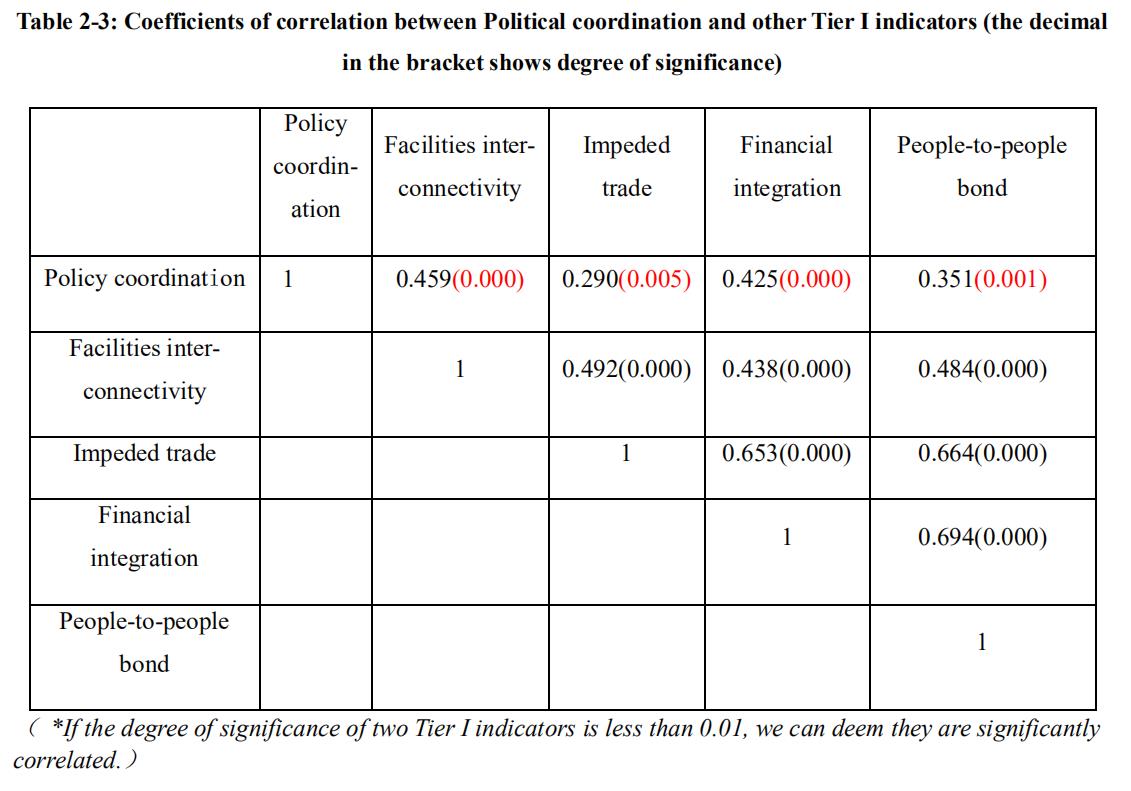
As the number of countries along the B&R is expanded to 94 in the present annual report, in order to better reflect the differences, the research group divides the countries into five categories according to the measurement criteria and scores: smooth cooperation nation; interconnected nation; good cooperation nation; nation of potential for cooperation; nation of weak cooperation. This is illustrated in the following figure. The average score of policy coordination of countries along the B&R is 10.96, which reaches the level of "good" and is consistent with the overall level of Five Connectivity Index. Regionally, Central Asia and Mongolia, Southeast Asia, Eurasia and Europe scored above average, while South Asia, West Asia, North Africa and Oceania scored below average. Among them, Central Asia and Mongolia has the best policy coordination effect with China under the framework of BRI, followed by Southeast Asia. This also demonstrates the importance of aligning regional and international cooperation mechanisms with the BRI. The low scores of West Asian and North African countries also reflect the lack of an effective cooperation mechanism with China for politic synergy on the BRI. The above analysis highlights the multiple regional cooperation attributes of the BRI and the characteristics of the initiative to promote regional and even global cooperation and development through sub-regional cooperation mechanisms.
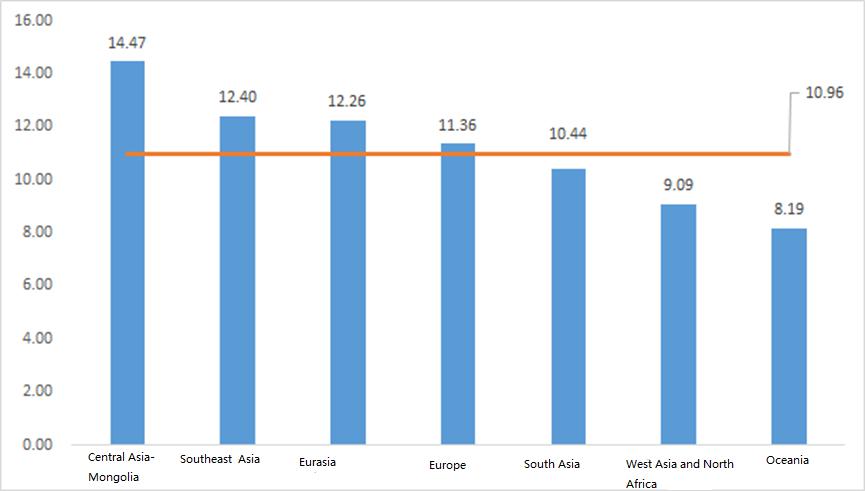

In 2017, there are 13 smooth cooperation nations in terms of policy coordination, accounting for 13.8 percent of the total, which is higher than that of last year. There are 20 interconnected nations, accounting for 21.3 percent; 27 good cooperation nations, accounting for 28.7 percent. Nations of potential for cooperation and nations of weak cooperation accounted for 16 percent and 20.2 percent respectively.
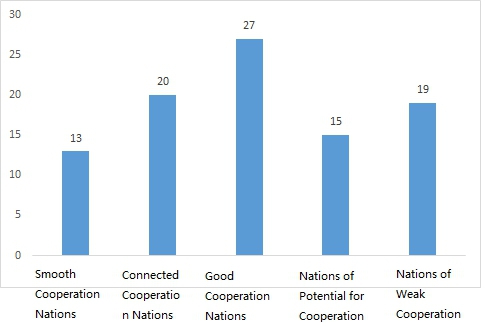
As shown in Figure 3, smooth cooperation nations, in terms of policy coordination, account for the least of all nations along the B&R, but they are the most important nations. There are 11 nations that have smooth cooperation in all five areas, and 13 nations that have smooth cooperation in the area of policy coordination: Russia, Cambodia, Serbia, Kazakhstan, Pakistan, Hungary, Laos, Poland, Belarus, Mongolia, Czech Republic, Kyrgyzstan and Uzbekistan. In terms of geographic distribution, four Central Asian and Mongolian nations are on the list, followed by Serbia, Poland and the Czech Republic. Pakistan is located in South Asia. Cambodia and Laos are Southeast Asian countries. It is clear that most of these nations are adjacent to China, and the number of nations along the Silk Road Economic Belt is more than that of those along the 21st Century Maritime Silk Road. As far as bilateral relations are concerned, these countries have actively supported China's Belt and Road Initiative on the basis of maintaining good political relations with China. Heads of State of nations of smooth policy coordination all attended the Belt and Road Forum for International Cooperation and were present at the Roundtable of the Belt and Road Forum for International Cooperation. All thirteen countries have signed memorandums of understanding with the Chinese government or synergy agreements through the Eurasian Economic Union.
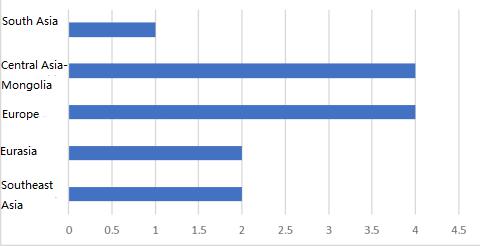
Russia remained at the top of the policy coordination index list, with a score of 18.07, ranking first for the third consecutive year, and ranked first in terms of total Five Connectivity Index scores for the third consecutive year. China and Russia, both permanent members of the UN Security Council and members of the BRICS countries, are major representatives of emerging countries and are playing an important role in world politics, security and economy. The two countries share common interests and needs on major international and regional issues and maintain high-level coordination and cooperation. High-level exchanges between leaders of the two countries are frequent (Russia gets full a full score in high-level exchanges with China), and the two countries have built a fixed mechanism for high-level exchanges. China and Russia have established a comprehensive strategic partnership of cooperation based on a solid foundation for policy coordination and cooperation under the Belt and Road Initiative. In May 2015, China and Russia jointly issued "Joint Statement of the People's Republic of China and the Federation of Russia on the Construction of the Silk Road Economic Belt and the Synergy Cooperation of the Eurasian Economic Union" and "Joint Statement of the People's Republic of China and the Federation of Russia on Deepening the Comprehensive Strategic Partnership for Cooperation and Advocating Win-Win Cooperation", actively promoting strategic synergy between the two countries.
Cambodia is at the second place. In December 2010, the two countries established a comprehensive strategic partnership of cooperation, ushering in a new era of comprehensive quality improvement and growth. China and Cambodia enjoy a high degree of political mutual trust. Based on a broad and high degree of political consensus, China and Cambodia have always understood, respected and supported each other in international and regional affairs. Cambodia has always been supportive of China's important role as a responsible country in safeguarding world peace and development. Cambodia has consistently supported China on issues related to Taiwan, the South China Sea and other issues that have a bearing on China's national sovereignty and core interests and major concerns. On the South China Sea issue, which involves China's core interests, Cambodia has given China firm and strong support in the international community and clearly opposed the South China Sea arbitration case. China and Cambodia have actively coordinated and cooperated under the frameworks of Lancang-Mekong Rivers Cooperation and China-ASEAN cooperation to jointly promote the building of a closer China-ASEAN community of shared destiny and make greater contributions to regional and world stability, development and prosperity. Cambodia, with a population of only 15.76 million, has opened embassies in Beijing and general consulates in Guangzhou, Shanghai, Hong Kong, Kunming, Chongqing, Nanning and Xi'an.
Serbia, a European country, is at the third place. Serbia is an important propeller of the Belt and Road Initiative proposed by President Xi Jinping. It is praised by China as "forever friend and sincere partner". Establishing a comprehensive strategic partnership in June 2016, China and Serbia are all-weather friends and important partners. The relations between the two countries have stood the test of history and have been renewed even after a long time. China and Serbia share similar positions on major international issues, and Serbia, facing NATO's siege, has firmly supported China's core interests on many international occasions.
Kazakhstan, which is at the fourth place on the list, is the origin area of the Silk Road Economic Belt. In 2011, China and Kazakhstan announced the development of a comprehensive strategic partnership, with high mutual trust and support for each other's core interests. Kazakhstan was one of the first countries to sign a BRI agreement with China. On September 2nd 2016, the two governments signed Cooperation Plan for the Construction of the Silk Road Economic Belt and the New Economic Policy of the Bright Road, which has become an important political document guiding China-Kazakhstan practical cooperation.
Pakistan, which is at the fifth place on the list, has an "all-weather strategic partnership" with China. It is an "iron friend" of China and a staunch supporter and beneficiary of China's Belt and Road Initiative. China-Pakistan policy coordination score has always been quite high, but due to its political stability and the slightly low frequency of annual high-level contacts with China, Pakistan ranks the fifth in the 2018 report. Pakistan tops all other nations in terms of A3 Index (achievements of cooperation) with a score of 8. That is, Pakistan scores the highest in terms of the effectiveness of policy coordination.
There are 20 interconnected countries, most of which are in Southeast Asia, West Asia, North Africa and Europe. Thailand and Singapore are the major countries on the 21st Century Maritime Silk Road. They have been actively supporting the Belt and Road Initiative and have signed the Memorandum of Understanding with China. The main reason why they are not included in the smooth cooperation nations is that the heads of state did not participate in the Belt and Road Forum for International Cooperation. Vietnam, which was the first country President Xi Jinping visited after the 19th National Congress of the Communist Party of China (CPC), supported the Belt and Road Initiative, but failed to sign the Memorandum of Understanding with China and scored low on issues, such as territorial disputes, affecting political trust. Myanmar's policy coordination score has improved considerably, and the intuitive quantitative results show that the NLD government attaches increasing importance to the Belt and Road Initiative and relies heavily on the Chinese government.
In addition to its high degree of political stability (full score of 1) and stable Sino-Swiss relations, Switzerland is included in the second-tier nations mainly because its head of state, Leuthard (President of Confederation of the Federal Council of Switzerland), attended the Belt and Road International Forum, and Switzerland, as a developed Western country, expressed its support for China's Belt and Road Initiative with concrete actions. Greece and Austria from Europe have been active in the Belt and Road Initiative and are in second order nations. Greek Prime Minister Tsipras not only attended the Belt and Road Forum, but also signed a package of cooperation documents during the Forum. The main reason for Greece's relatively low score is the low level of high-level exchanges between the two countries. Oman, Turkey and Kuwait, all included in second order countries, are in West Asia and North Africa. They have all signed Memorandums of Understanding with the Chinese government. Turkish President Erdogan attended the Belt and Road Forum to express support for the initiative. New Zealand is the only country in Oceania to have signed a Memorandum of Understanding with the Chinese government, and it is in a leading position in Oceania in aligning the Belt and Road Initiative.
The number of countries in the third tier (good cooperation nations) is the highest. Geographically, these types of countries are mainly distributed in West Asia, North Africa and Europe, with some in Southeast Asia, Eurasia and Oceania. There are 14 European countries included, accounting for half of the total, indicating that the overall level of policy coordination among European countries is similar. There is no territorial dispute between China and European countries, and the political mutual trust between China and EU countries is high. There is great potential for strengthening institutional building under the framework of the Belt and Road Initiative. Most of the countries in West Asia and North Africa have traditional friendships with China and enjoy high political mutual trust. However, there is still much room for improvement in the synergy of international cooperation mechanisms and specific policies between these countries and China, under the framework of the Belt and Road Initiative.
There are 15 nations with potential for cooperation (fourth-tier nations), most of which are developed European countries and small countries along the B&R. Britain, France and Germany, in Europe, all support China's Belt and Road Initiative, but substantial progress has yet to be made in policy alignment.
The fifth-tier nations are those of weak cooperation. Iraq, Syria, Yemen and Palestine, which have been included in this tier for three consecutive years, due to poor domestic political environment, lack the capacity to engage in effective policy cooperation with China within the framework of the Belt and Road Initiative; their political stability has not improved effectively. India and Australia, both as influential regional powers in fifth-tier, are two major countries that have explicitly opposed China's Belt and Road initiative. In 2017, the "Doklam Crisis" broke out between China and India, and the strategic mutual trust between the two sides approached zero. Indian leaders repeatedly opposed China's BRI on international occasions because the "China-Pakistan Economic Corridor" violated their territory and sovereignty. However, as a large country and a member of many international cooperation mechanisms, the score of high-level exchanges between China and India is 0.8, second only to Russia. Frequent high-level interaction between China and India was conducive to the eventual peaceful settlement of the "Doklam crisis". The Australian government has all along refused to align with the BRI. As a non-South China Sea party, it frequently intervenes in the South China Sea issue and supports the US position of upholding the so-called "freedom of navigation" in the South China Sea. In addition, India, Australia and the United States and Japan put forward the Indo-Pacific Strategy, and formed a "four-party dialogue" mechanism, which was intended to check China.
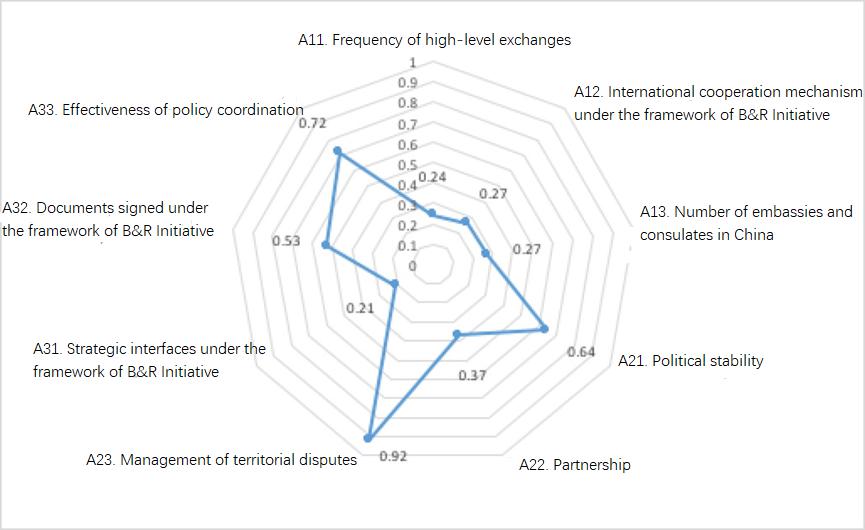

The policy coordination index of "The Belt and Road Initiative: 2018 Report on Five Connectivity Indexes" designs and selects indicators based on the framework of the Belt and Road Initiative, which can reflect the policy coordination level between China and countries along the Belt and Road objectively and visualized, and provide support and reference for decision-making and implementation agencies. The traditional empirical proposition that bilateral political mutual trust plays a fundamental role in promoting the Belt and Road Initiative is further supported by objective data calculations, which has certain guiding significance for the future diplomatic work with countries along the Belt and Road. The measurement of mutual trust also clarifies the focus of diplomatic work in the next step and enables us to anticipate and avoid risks in the construction of the Belt and Road Initiative in advance, thus reducing unnecessary losses.
Moreover, it is difficult to quantify policy and diplomacy, and a perfect system of indicators is almost impossible to foresee in the short term. The indicator system of the research group shows that the scores of countries in West Asia and North Africa are low, and the scores of large countries, especially those that support China's Belt and Road Initiative, are higher. The Belt and Road Initiative is an international cooperation initiative, which has significant attributes of multilateral international cooperation mechanism. Therefore, this indicator system focuses on the policy alignment within international cooperation and regional cooperation under the framework of the Belt and Road Initiative. First, compared to ASEAN countries and CEE countries under the 16 +1 cooperation mechanism, the countries in West Asia and North Africa lack an influential regional organization for effective policy alignment. Second, countries along the B&R are mainly small and medium-sized countries. Compared with large countries, small countries, due to their innate circumstances have fewer high-level exchanges with the Chinese government and fewer embassies and consulates in China, which has a negative impact on the results. Third, some governments have yet to recognize the importance of supporting China's Belt and Road Initiative in developing relations with China, and the degree of attention and support needs to be further enhanced. Finally, bilateral annual political disputes have a strong impact on the outcome.
—————————————————————
FOCUS ON CONTEMPORARY NEEDS.
Should you have any questions, please contact us at public@taiheglobal.org